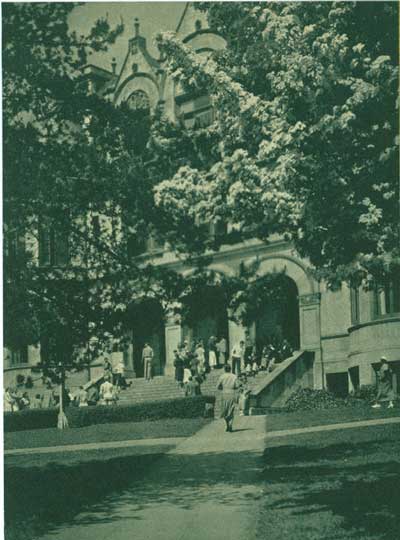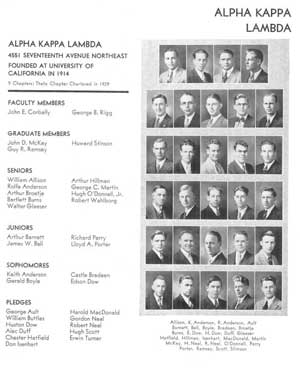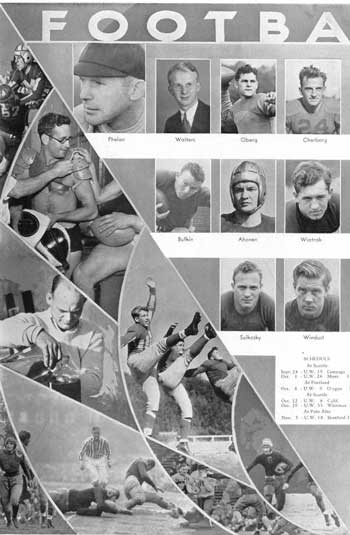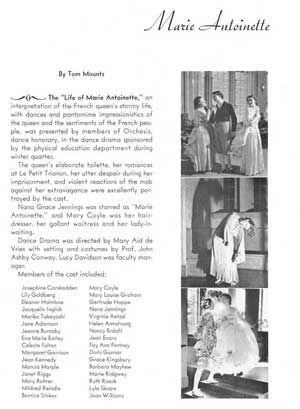by Annie Walsh

Students entering Denny Hall at the University of Washington, from the 1934 "Tyee" yearbook. Student life during the Depression was changed by budget cuts and tuition rates, yet there was a thriving athletic, social, and cultural atmosphere on campus.
The University of Washington was a well-respected, well-attended university in 1929, with numerous academic and vocational opportunities, a growing faculty, a beautiful campus, and an energetic and involved student body. There were countless groups, clubs, activities, committees, and organizations available to foster a lively student community, sponsoring eleven formal and informal dances in 1929 alone. The Great Depression, however, forced the University onto a much smaller scale and budget, reducing the formal academic and social opportunities of students. However, students during the Depression years found ways to keep their school spirit alive and contribute to the welfare of the University community despite the budget cuts. By reviewing the University of Washington catalog and yearbooks during the Depression era, we can gain a picture of student and faculty life at the University, from academics and costs to athletics, social life, and room and board, and see how students dealt with the economic crisis.
From 1929–1934, there were two ways to be admitted into the University of Washington: obtaining a certificate from an accredited high school along with a letter of recommendation from that high school principal, or by passing a general admission examination. Once admitted, all students were required to have a medical examination and pass an intelligence test. The first medical exam and intelligence test were free, but if students needed more than one, it would cost them $5.00 for the medical exam and $1.00 for the intelligence test.[1]
After being accepted to the University of Washington, students were admitted to a specific college depending on their major. In existence in 1929 were the colleges of Liberal Arts, Fine Arts, Business Administration, Science, Engineering, Forestry, Journalism, Law, Fisheries, Mines, Pharmacy, Education, and the School of Library Science.[2] While the College of Forestry and the College of Mines no longer exist, and others have been evolved and many new colleges added, the foundation of today’s University can still be found in this original academic division.
Tuition for students at the University of Washington stayed fairly consistent from 1929 to 1934. In 1929, resident undergraduates paid $15.00 per quarter and $25.00 for summer quarter, while non-residents paid $50.00 per quarter.[3] Students were also required to pay $10.00 per year for an Associated Student (ASUW) fee, $5.00 per quarter in incidental fees, $1.00 per quarter for health services, $1.00 per quarter for a library fee, including any additional variable lab fees.[4] These numbers shifted slightly in 1932, when tuition for resident undergraduates decreased to $10.00 per quarter, but the incidental, heath service, and library fees were combined as one $11.00 fee, saving students $1.00 per quarter.[5] Students who maintained good grades were able to obtain promissory notes for academic loans at four percent per year, a rate that remained constant from 1929–1934.[6]

Fraternities and sororities were popular living options, and each was given its own page in the yearbook as shown here from 1931. (Image courtesy of the University of Washington Library, Special Collections)
Room and board expenses were also a concern of UW students. Lewis and Clark residence halls were available to female students and cost $32.00 per month. The University added several women’s halls between 1929 and 1932, but the price of room and board remained the same. Lander Hall, for male students, cost $36.00 per month in 1929–30, with a slight increase in 1931. Living off campus was also an option, with rooms ranging from $35.00–$40.00 per month; these rates also increased during the 1931-32 school year to $38.00-$45.00 per month, but fell back to the previous rates the following year.[7] Fraternities and sororities were a popular option, with anywhere between 39–42 fraternities and 24–26 sororities open during the 1929–1933 school years.[8]
Enrollment numbers at the University of Washington began declining as the Great Depression took hold in the Northwest. The table below shows a sharp decline in enrollment beginning in the 1931–32 school year and continuing decline through the 1932–33 terms. There was a tremendous increase in 1933–34, but it would take a couple of years to rebound fully.
|
1929-1930[9] |
1930-1931[10] |
1931-1932[11] |
1932-1933[12] |
1933-1934[13] |
Men |
4,818 |
5,017 |
4,774 |
4,324 |
5,070 |
Women |
3,576 |
3,566 |
3,141 |
2,869 |
3,399 |
Total |
8,394 |
8,583 |
7,915 |
7,193 |
8,469 |
The Great Depression was a difficult time for the students of the University of Washington, but it was also a difficult time for the faculty. The number of professors on staff began to decline from 100 in 1930–31 to 80 in 1932–33 before rebounding significantly from 1933–1935 to just over 100 again.[14] There was also a decline in the number of Associate Professors, Assistant Professors, Lecturers, Instructors, and Associates during the Depression because of lower enrollment numbers as well as financial difficulties. Those who did keep their jobs were subject to a ten percent pay cut in 1932[15] and again in 1933 when one of the headlines in The University of Washington Daily paper read, “Faculty Salaries Again Cut; Regents Readjust U. Budget.”[16] Some of the faculty left for higher paying jobs elsewhere, but many chose to ride out the Depression at UW.
In 1929, the University of Washington had five publications: The University of Washington Daily, the main student news source; Columns, a monthly humor magazine; The Forest Club Quarterly, The Washington Law Review, ASUW News Service, and The University of Washington Tyee, the University yearbook. The Depression affected all of these publications, and those that survived faced budget cuts. Columns had to reduce the number of pages it printed, while The University of Washington Daily stopped producing a Monday edition and in 1932 began offering academic credit for executive work on the paper.[17] The Tyee shrank along with the budget, from 410 pages in 1929 and 391 pages in 1931 to a mere 272 pages by 1933.[18] The Forest Club Quarterly and the ASUW News Service simply disappeared.

The Husky men's football team, shown in the 1933 yearbook. Sports and athletic clubs gave students a sense of community and school spirit that eased the larger social crisis of the Great Depression.
Athletics at the University of Washington were an important component of bringing students together to show their school spirit, just as they are now. Major men’s sports included football, crew, basketball, track, baseball, and tennis. There were also some intramural and minor sports, including boxing, wrestling, golf, and cross-country. There were no cheerleaders, but there was a yell staff of five enthusiastic men with huge megaphones to rouse the crowd. Times were tight, and while it cost students $2.00 to attend football games in 1929, the cost of tickets didn’t seem to deter student fans. Unfortunately, many of the intramural and minor sports were eliminated during the Depression due to budget cuts.[19]
Women at the University of Washington had a large variety of activities and sports to choose from. There were the traditional sports: baseball, basketball, volleyball, tennis, swimming, and golf, but there were also some sports/activities that have since left the University: badminton, horseshoes, horseback riding, clogging, canoeing, dance drama, archery, and fencing. There was even a women’s “W Club,” for women who showed exceptional ability in sports and exhibited good sportsmanship. There was a women’s debate club, a women’s glee club formed in 1933, and the traditional junior girls’ vaudeville show every spring. As with the men’s intramural and minor sports, many of these women’s sports and activities were eliminated during the Depression. Most of the traditional sports were reinstated during more prosperous times, but many of the non-traditional activities, such as horseback riding and clogging, were not as fortunate.
The University of Washington was also home to many community service and religious clubs. The Knights of the Hook was an organization of underclassmen who provided community service to the University, while the Spurs, a national service organization for underclass women, also provided various services on campus. There was an annual tree planting day and a campus day where students did gardening and caretaking of the campus grounds. There were also many religious clubs on campus that represented a variety of Christian denominations, among them Catholic, Baptist, Episcopal, Methodist, and Presbyterian.[20] The religious clubs survived and in many cases thrived during the Depression because many people were looking for someway to keep faith during this difficult time.
Two things that University of Washington students did not lack during this period were school spirit and a flair for the dramatic. Homecoming was a particularly huge celebration for students, involving a giant wood sign-making contest. In 1932 the University of Washington Huskies played Washington State’s Cougars homecoming weekend, and the fruits of the sign-making competitions could be seen at the game involving the school mascots. One sign read “Give the Cougar a Husky Boot,” and pictured a UW student in boots kicking a cougar in the hindquarters. The other was the “K-9 Bar-B-Q,” which advertised a homecoming special of “Fresh Cougar Meat,” being freshly prepared by a Husky dog.[21] UW students also used signs to show their school spirit in the stands at games or to send a message to their opponents.

Drama was a significant part of UW student life during the 1930s. Here is the UW Drama Department's 1934 production of Marie Antoinette, from the 1934 yearbook. Click image to enlarge. (Courtesy University of Washington Library, Special Collections)
Dramatic flair was also exhibited by students’ theatre productions. UW students liked to watch as well as perform. There was a “Theatre Page” in The University of Washington Daily where students could find out which shows were playing in the Seattle area and where. There were numerous theatres in the Seattle area, and all of them advertised in The University of Washington Daily: The Egyptian, The Neptune, The Blue Mouse, The Fox Theatre, The Paramount, The Orpheum, The Pantages, The Moore, The 5th Avenue, and Seattle’s Repertory Playhouse.[22] The Drama Department at UW also put on its own productions, staging A Midsummer’s Night’s Dream in 1929, The Inspector General in 1930, The Critic in 1931, Electra in 1932, Camille in 1933, and Marie Antoinette in 1934.[23]
Although the significant budget cuts during the Great Depression caused the elimination of many clubs, activities, organizations, sports, dances, and extracurricular activities, UW students never lost their school spirit. Students provided community services on campus and in the community, supported their sports teams, and found ways to keep campus social life vibrant, all of which laid the groundwork for the University’s resurgence and growth after the Depression.
Copyright (c) 2009, Annie Walsh
HSTAA 353 Fall 2009
[1] University of Washington Catalog 1929-30, 59-60.
[2] University of Washington
Tyee, 1929.
[3] UW Catalog 1929-30, 61.
[4] UW Catalog 1929-30, 61-62.
[5] UW Catalog 1932-33, 48.
[6] UW Catalog 1929-30, 61.
[7] UW Catalog 1929-30, 67 and 71.
[8] UW
Tyee 1929-1933
[9] UW Catalog 1929-30, 407.
[10] UW Catalog 1930-31, 437.
[11] UW Catalog 1931-32, 307
[12] UW Catalog 1932-33, 275
[13] UW Catalog 1933-34, xxxi
[14] UW Catalog 1934-35, 9-10; 12-29; 14-32.
[15] The University of Washington Daily, 6/1/1932.
[16] UW Daily, 4/4/1933.
[17] UW
Tyee, 1932.
[18] UW
Tyee, 1929-1933.
[19] UW
Tyee, 1929-1933.
[20] UW
Tyee, 1929-1933.
[21] UW
Tyee, 1932.
[22] UW Daily, 11/1/1930.
[23] UW
Tyee 1929-1934.




